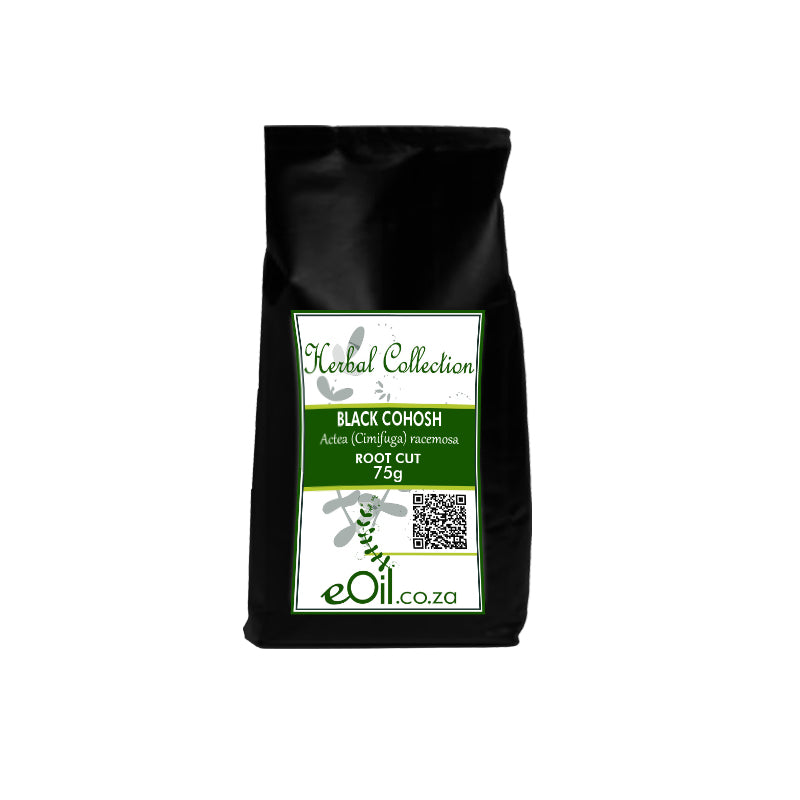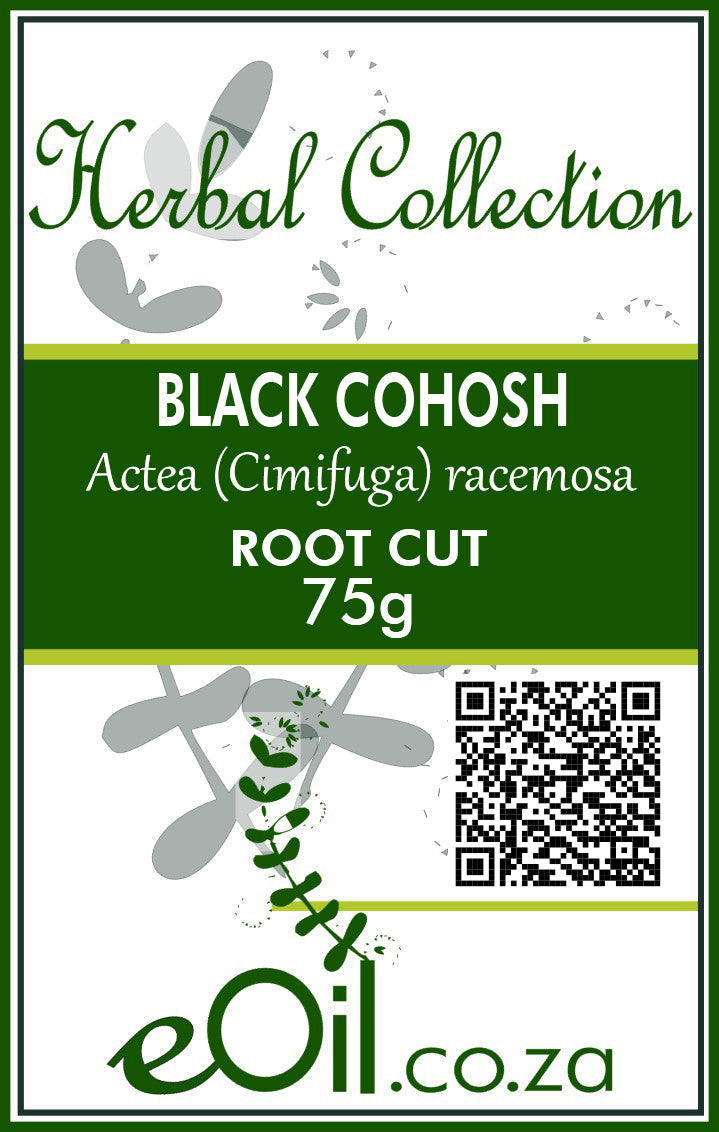Black Cohosh Root Dried Cut - Herbal Collection
Black Cohosh Root Dried Cut - Herbal Collection - 75 GR is backordered and will ship as soon as it is back in stock.
Description
Description
Black Cohosh Root Dried Cut (Cimicifuga racemosa) is a wild-harvested herb valued in traditional herbal practices.
Its rich, earthy flavor makes it ideal for herbal teas, tinctures, or natural blends.
It is a classic botanical ingredient for home herbalists and culinary enthusiasts
TRADITIONALLY USED
Black cohosh (Actaea racemosa or Cimicifuga racemosa) is a perennial plant native to North America, particularly the eastern woodlands.
It has been traditionally used by Native Americans and, later, by European settlers for a variety of medicinal purposes.
The root of the black cohosh plant is particularly valued for its potential health benefits.
- Menopause relief: One of the most well-known uses of black cohosh is for alleviating menopause symptoms, such as hot flashes, night sweats, mood swings, irritability, and vaginal dryness. It is believed that the plant's phytoestrogens may help to balance hormones in the body, providing relief from these symptoms.
- Menstrual discomfort: Black cohosh has also been used traditionally to ease menstrual cramps, bloating, and other discomforts associated with menstruation. Its anti-inflammatory and antispasmodic properties may help to relax the muscles of the uterus and reduce inflammation, easing pain and discomfort.
- Arthritis and joint pain: The anti-inflammatory properties of black cohosh root may help to alleviate pain and inflammation in those suffering from arthritis or joint pain. Some people take it as a supplement to help manage these conditions.
- Sleep aid: Black cohosh has been traditionally used as a natural sleep aid, particularly for menopausal women experiencing insomnia. The plant is believed to have sedative effects that can promote relaxation and improve sleep quality.
- Anxiety and depression: Some traditional uses of black cohosh root include the treatment of anxiety and depression, particularly in menopausal women. Its potential mood-boosting effects may be attributed to its influence on hormone levels and neurotransmitters.
- Antioxidant properties: Black cohosh root contains several compounds with antioxidant properties, which can help protect the body from oxidative stress and cellular damage.
INFORMATION
Source : http://www.wikiphyto.org/wiki/Black Cohosh
Reference on http://www.wikiphyto.org
Translation in English by Google Translate (go to the page of the source linked | on Chrome cellphones go on the 3 dots on the top right and select translate in your preferred language | on laptop right click your mouse and select option translate when hoovering on the page
plant name
Black cohosh , Black cohosh , Black cohosh , Black cohosh , Black cohosh , Black cohosh
International Latin denomination
Cimicifuga racemosa (L.) Nutt. = Actaea racemosa L.
botanical family
Ranunculaceae
Description and habitat
- Plant from North America, Canada and the United States, herbaceous, vigorous, up to 2 meters high, with large leaves composed of incised and toothed leaflets, with small white flowers and in clusters
History and tradition
- Used by Native American Aboriginal tribes, for rheumatism, sore throat, kidney disease, malaria, bronchitis, chorea, dropsy, fever, hysteria, amenorrhea, menstrual disorders and to accelerate childbirth (stimulation of uterine contractions)
- Listed in the British Pharmacopoeia until the beginning of the 20th century
- Much better efficacy has been observed in women
Parts used
- Underground parts, rhizome and adjacent roots
Dosage forms available
- Mother Tincture of Underground Parts
- Dry extract
Usual dosages
- 40 mg to 80 mg / day of dry extract [1]
Composition
Main components of the plant
- Flavonoids : isoflavones (substance with estrogenic activity, formononetin )
- Cycloartanol -derived tetracyclic triterpenes ( actein , cimifugoside ), cimiracemosides A to H [2]
- Tannins
- Phenol acids
- Alkaloids including cytisine and methyl-cytisine
- Sugars, fatty acids
Main components of buds or young shoots
Main components of essential oil
Properties
Plant properties
- Anti-inflammatory and diuretic
- Estrogenic activity: binding to estrogen receptors through an isoflavone , formononetin , with a described dopaminergic effect [3]
- Anti-estrogenic properties described [4] , Cimicifuga extracts inhibit the proliferation of estrogen receptors [5] , [6] , it has been tested favorably in hot flashes of menopause, associated with tamoxifen [7]
- Cohosh and tamoxifen, used simultaneously, would provide a synergistic effect thus increasing the inhibitory activity of the product by the plant. Please note: this does not imply that black cohosh can be used as a drug against breast cancer or that it does not pose a long-term problem.
- Decreases LH level in ovariectomized rat, estrogen receptor modulating activity, osteoblastic activity [8] , [9]
- The results of a literature review suggest that Cimicifuga racemosa has more central activity than peripheral hormonal effect [10].
- Osteoblastic effect and slight estrogenic effect on the vaginal mucosa [11]
- Activity on hot flushes by action on hMOR morphine receptors [12] and by a serotoninergic effect [13]
- Hypotensive and vasodilator: vascular effects on the inner ear
- Antispasmodic and sedative
- Attention to the action on breast cancer: almost 70% of breast cancers are of the hormone-dependent type
- In vitro results of black cohosh suggest a blocking effect on cancer cells and a restraining action of estradiol (by triterpenes )
Bud properties
Properties of essential oil
Indications
Indications of the whole plant (phytotherapy)
- Improvement of menopausal symptoms [14] , [15] , [16] , [17] , [18] , in a randomized, double-blind, placebo-controlled trial of 180 patients with climacteric disorders, treated for 12 weeks [19] , however some sources claim that clinical efficacy in treating menopausal symptoms has not been convincingly demonstrated in rigorous clinical trials [20] , [21]
- Steroidal insufficiency in women: hormonal regulation in dysmenorrhea and climacteric syndrome [22]
- Improvement of mood disorders in postmenopausal women, by action on serotonin (?) [23]
- A mixture of St. John's Wort and Black Cohosh would be as effective as hormone therapy in menopausal disorders without the side effects (the combination of Cimicifuga and Hypericum perforatum in hot flushes would give 78% good results)
- Inhibition of the proliferation of certain prostate cancer cell lines [24] , [25]
- ENT pathology: ringing in the ears
- High blood pressure (?)
Indications of the bud (gemmotherapy)
Specific indications of essential oil (aromatherapy)
Known or suspected mode of action
Usual formulations
Regulations
- In France, the first dilution delivered is the 1 DH
- French Pharmacopoeia list A (underground part)
- Use recognized by EMA (European Medicines Agency), WHO (World Health Organization), Commission E of the German Ministry of Health, ESCOP (European Scientific Cooperative on Phytotherapy)
Possible side effects and precautions for use
- Gastric disorders
- Hepatotoxic risks [26] , [27]
- Other studies do not indicate a notable risk of toxicity [28]
- Pharmacokinetic interactions:
- Little interaction with cytochromes P450. Inhibition of CYP3A4 (by triterpenes ) [29] , no interaction with P-gP
- On the other hand interaction with the transporter OATP2B1, which could reduce the effectiveness of amiodarone (antiarrhythmic), fexofenadine (antihistamine), glibenclamide (antidiabetic), statins (hypocholesterolemics)
- Pharmacodynamic interactions:
- Additive effects with estrogens. Avoid in women with a history of breast cancer [30] or in case of other hormone-dependent disease. Caution with hepatotoxic drugs.
Bibliographic references
- Go↑ Mahady, Gail B. Black Cohosh (Actaea/Cimicifuga racemosa): Review of the Clinical Data for Safety and Efficacy in Menopausal Symptoms. Treatments in Endocrinology, Volume 4, Number 3, 2005 , pp. 177-184(8). PMID 15898823
- Go↑ Yu Shao, Amanda Harris, Mingfu Wang, Hongjie Zhang, Geoffrey A. Cordell, Mika Bowman, Ed Lemmo. Triterpene Glycosides from Cimicifuga racemosa. Journal of Natural Products 2000 63 (7), 905-910. PMID 10924163
- Go↑ Hubertus Jarry, Maria Metten, Barbara Spengler, Volker Christoffel, Wolfgang Wuttke. In vitro effects of the Cimicifuga racemosa extract BNO 1055. Maturitas, 2003, Volume 44, Supplement, Pages S31-S38. PMID 12609557
- Go↑ Oliver Zierau, Claudia Bodinet, Susanne Kolba, Marina Wulf, Günter Vollmer. Antiestrogenic activities of Cimicifuga racemosa extracts. The Journal of Steroid Biochemistry and Molecular Biology, Volume 80, Issue 1, January 2002, Pages 125-130. PMID 11867271
- Go↑ Bodinet Cornelia, Freudenstein Johannes. Influence of Cimicifuga Racemosa on the Proliferation of Estrogen Receptor-Positive Human Breast Cancer Cells. Breast cancer research and treatment, Volume 76, Number 1, 1-10. PMID 12408370
- Go↑ K. Hostanska, T. Nisslein, J. Freudenstein, J. Reichling, R. Saller. Cimicifuga racemosa Extract Inhibits Proliferation of Estrogen Receptor-positive and Negative Human Breast Carcinoma Cell Lines by Induction of Apoptosis. Breast cancer research and treatment, Volume 84, Number 2, 151-160. PMID 14999145
- Go↑ Gerardo Hernández Muñoz, Salvatore Pluchino. Cimicifuga racemosa for the treatment of hot flushes in women surviving breast cancer. Maturitas, Volume 44, Supplement, Pages S59-S65 (14 March 2003). PMID 12609560
- Go↑ D Seidlova-Wuttke, O Hesse, H Jarry, V Christoffel, B Spengler, T Becker, W Wuttke. Evidence for selective estrogen receptor modulator activity in a black cohosh (Cimicifuga racemosa) extract: comparison with estradiol-17beta. European Journal of Endocrinology, Vol 149, Issue 4, 351-362. PMID 14514351
- Go↑ Düker EM, Kopanski L, Jarry H, Wuttke W. Effects of Extracts from Cimicifuga racemosa on Gonadotropin Release in Menopausal Women and Ovariectomized Rats. Planta Med 1991; 57(5): 420-424. PMID 1798794
- Go↑ F. Borrelli, A. A. Izzo, E. Ernst. Pharmacological effects of Cimicifuga racemosa. Life Sciences, Volume 73, Issue 10, 25 July 2003, Pages 1215-1229. PMID 12850238
- Go↑ Wuttke,Wolfgang, Gorkow C. Effects of black cohosh (Cimicifuga racemosa) on bone turnover, vaginal mucosa, and various blood parameters in postmenopausal women: a double-blind, placebo-controlled, and conjugated estrogens-controlled study. Menopause, 2006, Volume 13, Issue 2, pp 185-196. PMID 16645532
- Go↑ Rhyu MR, Lu J, Webster DE, Fabricant DS, Farnsworth NR, Wang ZJ. Black cohosh (Actaea racemosa, Cimicifuga racemosa) behaves as a mixed competitive ligand and partial agonist at the human mu opiate receptor. J Agric Food Chem. 2006 Dec 27;54(26):9852-7. PMID 17177511 Texte intégral : [1]
- Go↑ Burdette JE, Liu J, Chen SN, Fabricant DS, Piersen CE, Barker EL, Pezzuto JM, Mesecar A, Van Breemen RB, Farnsworth NR, Bolton JL. Black cohosh acts as a mixed competitive ligand and partial agonist of the serotonin receptor. J Agric Food Chem. 2003 Sep 10;51(19):5661-70. PMID 12952416
- Go↑ Lieberman Shari. A Review of the Effectiveness of Cimicifuga racemosa (Black Cohosh) for the Symptoms of Menopause. Journal of Women's Health. June 1998, 7(5): 525-529. PMID 9650153
- Go↑ Rossella E Nappi, Barbara Malavasi, Benedetta Brundu, Fabio Facchinetti. Efficacy of Cimicifuga racemosa on climacteric complaints: A randomized study versus low-dose transdermal estradiol. Gynecological Endocrinology, 2005, Vol. 20, No. 1 , Pages 30-35. PMID 15969244
- Go↑ S. Frei-Kleiner, W. Schaffner, V.W. Rahlfs, Ch. Bodmer, M. Birkhäuser. Cimicifuga racemosa dried ethanolic extract in menopausal disorders: a double-blind placebo-controlled clinical trial. Maturitas, 2005, Volume 51, Issue 4, Pages 397-404. PMID 16039414
- Go↑ Mohammad-Alizadeh-Charandabi S, Shahnazi M, Nahaee J, Bayatipayan S. Efficacy of black cohosh (Cimicifuga racemosa L.) in treating early symptoms of menopause: a randomized clinical trial. Chin Med. 2013 Nov 1;8(1):20. doi: 10.1186/1749-8546-8-20. PMID 24499633
- Go↑ Uebelhack R, Blohmer JU, Graubaum HJ, Busch R, Gruenwald J, Wernecke KD. Black cohosh and St. John's wort for climacteric complaints: a randomized trial. Obstet Gynecol. 2006 Feb;107(2 Pt 1):247-55. Comment in: Evid Based Med. 2006 Oct;11(5):148. PMID 1644910
- Go↑ Schellenberg R, Saller R, Hess L, Melzer J, Zimmermann C, Drewe J, Zahner C. Dose-Dependent Effects of the Cimicifuga racemosa Extract Ze 450 in the Treatment of Climacteric Complaints: A Randomized, Placebo-Controlled Study. Evid Based Complement Alternat Med. 2012;2012:260301. doi: 10.1155/2012/260301. PMID 23346194
- Go↑ Francesca Borrelli, Edzard Ernst. Cimicifuga racemosa: a systematic review of its clinical efficacy. European Journal of Clinical Pharmacology 2002, Volume 58, Number 4, 235-241
- Go↑ Francesca Borrellia, Edzard Ernst. Black cohosh (Cimicifuga racemosa) for menopausal symptoms: A systematic review of its efficacy. Pharmacological Research, Volume 58, Issue 1, July 2008, Pages 8-14. PMID 18585461
- Go↑ Liske E. Therapeutic efficacy and safety of Cimicifuga racemosa for gynecologic disorders. Advances in Natural Therapy, 1998, vol 15 N°1. PMID 10178637
- Go↑ Geller SE, Studee L. Contemporary alternatives to plant estrogens for menopause. Maturitas. 2006 Nov 1;55 Suppl 1:S3-13. PMID 16884867
- Go↑ Jarry H, Thelen P, Christoffel V, Spengler B, Wuttke W. Cimicifuga racemosa extract BNO 1055 inhibits proliferation of the human prostate cancer cell line LNCaP. Phytomedicine. 2005 Mar;12(3):178-82. PMID 15830838
- Go↑ Seidlová-Wuttke D, Thelen P, Wuttke W. Inhibitory effects of a black cohosh (Cimicifuga racemosa) extract on prostate cancer. Planta Med. 2006 May;72(6):521-6. PMID 16773536
- Go↑ Levitsky J, Alli TA, Wisecarver J, Sorrell MF. Fulminant liver failure associated with the use of black cohosh. Dig Dis Sci. 2005 Mar;50(3):538-9. Erratum in Dig Dis Sci. 2008 Mar;53(3):869. PMID 15810638
- Go↑ Cohen SM, O’Connor AM, Hart J et al. Autoimmune hepatitis associated with the use of black cohosh: a case study. Menopause 2004;11:575-7. PMID 15356412
- Go↑ Low Dog T, Powell KL, Weisman SM. Critical evaluation of the safety of Cimicifuga racemosa in menopause symptom relief. Menopause. 2003 Jul-Aug;10(4):299-313. PMID 12851513
- Go↑ Sachiko Tsukamoto , Maki Aburatani, Tomihisa Ohta. Isolation of CYP3A4 Inhibitors from the Black Cohosh (Cimicifuga racemosa). Complementary and Alternative Medicine, Advance Access published on June 1, 2005. http://ecam.oxfordjournals.org/cgi/reprint/2/2/223
- Go↑ Mayo Clinic 2010, Black cohosh (Cimicifuga racemosa [L.] Nutt.) http://www.mayoclinic.com/health/black-cohosh/NS_patient-blackcohosh
- Shams T, Setia MS, Hemmings R, McCusker J, Sewitch M, Ciampi A. Efficacy of black cohosh-containing preparations on menopausal symptoms: a meta-analysis. Altern Ther Health Med. 2010 Jan-Feb;16(1):36-44. PMID 20085176
- Borrelli F, Ernst E. Alternative and complementary therapies for the menopause. Maturitas. 2010 Aug;66(4):333-43. Epub 2010 Jun 30. PMID 20580501
- Osmers R, Friede M, Liske E, Schnitker J, Freudenstein J, Henneicke-von Zepelin HH. Efficacy and safety of isopropanolic black cohosh extract for climacteric symptoms. Obstet Gynecol. 2005 May;105(5 Pt 1):1074-83. Erratum in Obstet Gynecol. 2005 Sep;106(3):644. PMID 15863547
CAUTION
Store in a cool, dry place, away from light. Keep tightly closed, away from the reach of Children and pets.
Do not exceed the daily dose.
This product is not intended to prevent or cure any form of illness or disease.
If you are pregnant or nursing ; If you have a medical condition or are in the course of medical treatment ; If you are programmed for theater/operation in the near future, please consult your healthcare practitioner before using this product.
This product cannot replace a varied and balanced diet and a healthy lifestyle.
This product has not been evaluated by the SAHPRA for its quality, safety or intended use.
For More Information please check our General Safety Herbal products Page

Black Cohosh Root Dried Cut - Herbal Collection - 75 GR is backordered and will ship as soon as it is back in stock.






